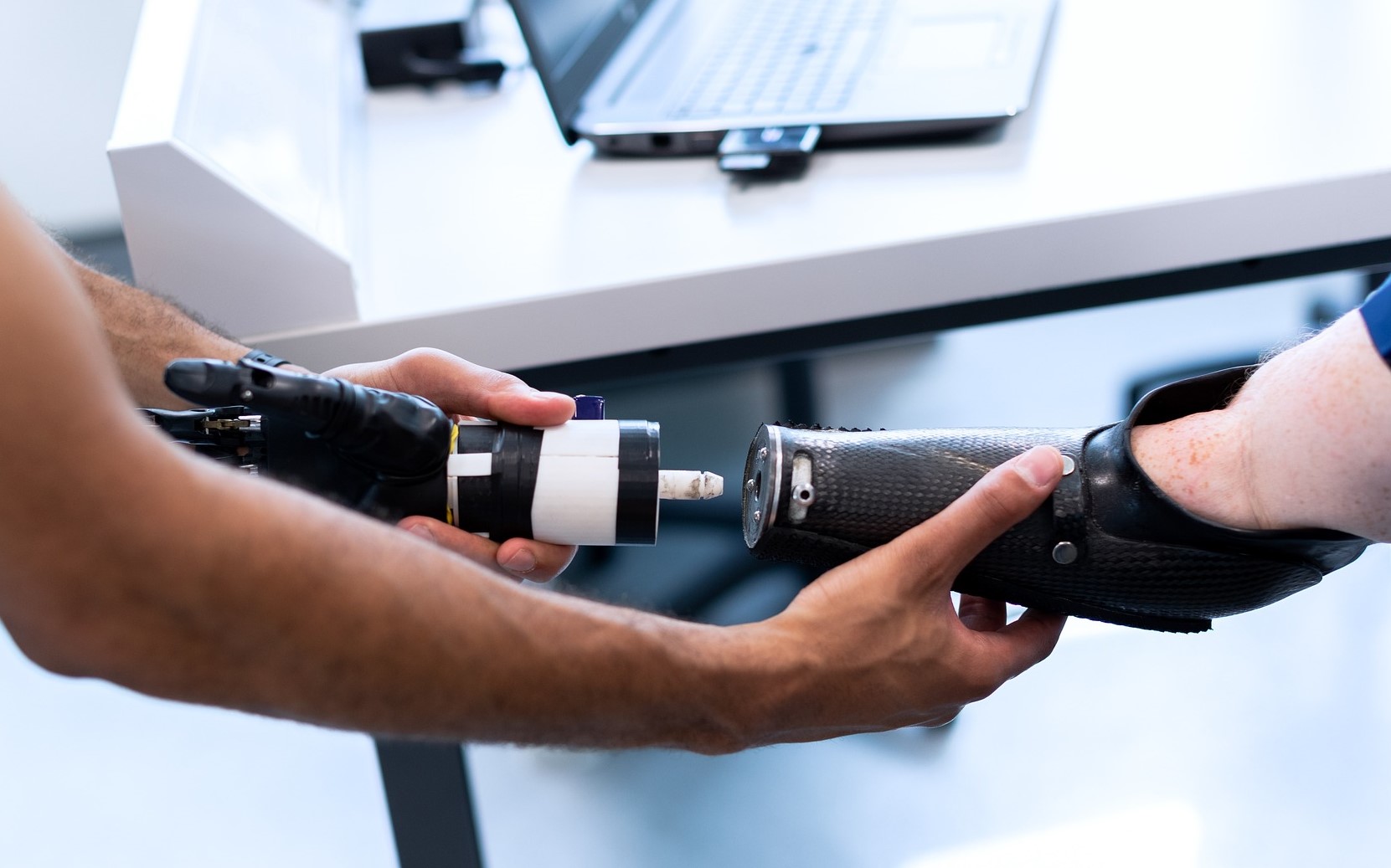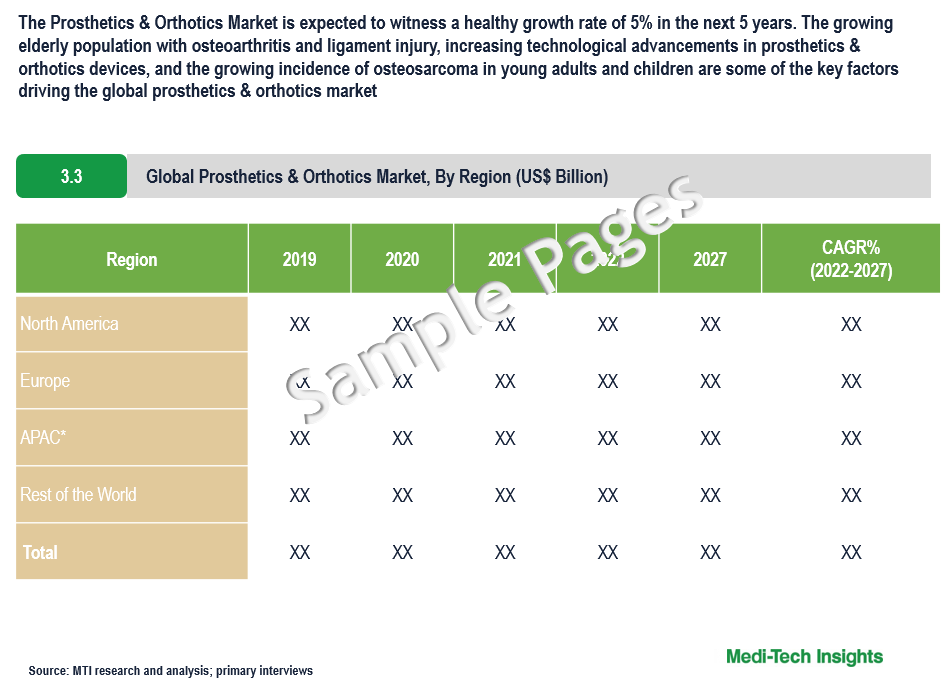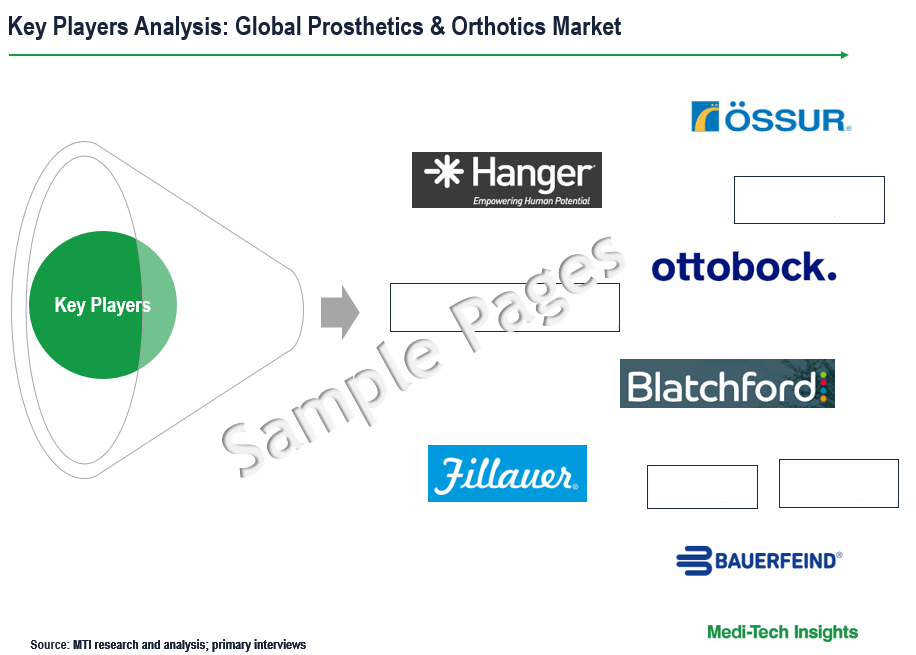
Prosthetics and Orthotics Market Size, Share, Trends & Growth Analysis by 2027

The Global Prosthetics and Orthotics Market was valued at ~$4 billion in 2022 and is expected to grow at a rate of ~5% by 2027. Growing elderly population with osteoarthritis and ligament injury, rapid technological advancements in prosthetics & orthotics devices, a rising number of sports injuries and road accidents globally, an increasing number of osteosarcoma in young adults and children, and surging demand for user-friendly prosthetics which need minimal training are some of the key factors driving the market growth. However, the high cost of prosthetic & orthotic devices is likely to hamper the growth of the prosthetics and orthotics market in the coming years.
Prostheses and orthoses enable people with physical impairments or functional limitations to live a healthy, productive, and independent life. Prosthetic products include artificial lower and upper limbs, liners, and related products for amputees while bracing & supports products are primarily used to support joints and other body parts for osteoarthritis patients and those with sports injuries.
Role of Orthotics in Reducing Foot & Ankle Pain Drives the Prosthetics and Orthotics Market
Orthoses are used primarily to control, stabilize or immobilize a joint. It can be used as fixed or mobile support, depending on the treatment plan to address various symptoms of pain and discomfort in the feet and legs such as correcting foot deformities, providing support to the ankle, reducing risks of further injuries, and helping the foot or ankle function better. Furthermore, it also helps in correcting feet that aren’t ideally positioned. The growing demand for orthotics devices in treating various conditions of the foot and ankle is likely to drive the prosthetics and orthotics market in the coming years.
Technological Advancements in Prosthetics and Orthotics Fuels the Demand of Prosthetics and Orthotics Market
As per WHO estimates nearly 30 million people need prosthetic and orthotic devices. Innovative solutions in this field improve the quality of life of amputees and those suffering from neurological diseases such as stroke, spinal cord injury, and multiple sclerosis. Further, technological advancements in the orthopedic field such as the 3D printing of implants and the introduction of bionic technology, and sensor technology in prosthetic limbs offer unprecedented growth opportunities in the global prosthetics and orthotics market.
For instance,
- In July 2022, WillowWood company announced the launch of its META Shock X, the third high-activity prosthetic foot from the META family. The revolutionary META feet combine responsive energy return with balance, stability, and impact protection. META feet are the industry’s first one-piece carbon design, free of hardware for a minimal and lightweight platform.
- In March 2022, Hanger Clinic announced that its proprietary AmpuShield limb protector has received an innovative technology contract from Vizient, Inc., the nation’s largest member-driven healthcare performance improvement company.

Trend Towards 3D Printed Prosthetics, Sensitive Limb-Based Products & Brain-Controlled Prosthetics Boosts the Growth of the Prosthetics and Orthotics Market
Prosthetic technology has advanced considerably to include lightweight running legs and more responsive legs and feet, allowing for more effective navigation. The future trend toward building more sensitive limb-based products and brain-controlled prosthetics with the advent of neuroprosthetics. Many of these technologies are still in development and could take several years before the most advanced prosthetics reach the global prosthetics and orthotics market. Some of the latest trends are listed below:
- 3D Printing: 3D printing technology streamlines the process of fabricating a prosthetic limb, speeding up the time the prosthesis gets to a patient. 3D printing prostheticsare also cheaper by thousands of dollars.
- More Sensitive Limbs: By wiring pressure sensors into the fingers of the artificial hand to the nerves in the upper arm, amputees can feel the shape and texture of objects. This helps patients to mimic the sensation of holding and controlling their motions.
- Brain-controlled Prosthetics: In this system, brain signals travel down nerves and control limb movement, and use those signals to optimize bionic prosthetic limbs known as myoelectric control systems, these prosthetics can move prosthetic arms and legs without conscious though.
- Passive Prosthetics Devices: The latest passive prosthetic technologies offer improvements in function and appearance. Some of the available options are custom silicone restorations, multi-positional joints, point digit, and titan titanium fingers.
North America is Expected to Continue to Hold a Major Share in the Prosthetics and Orthotics Market
From a geographical perspective, North America holds a larger market share of the global prosthetics and orthotics market. This can be mainly attributed to the increasing incidence of sports injuries and road accidents, the rising number of diabetes-related amputations, technological advancements in prosthetics & orthotics devices, and better healthcare coverage in the region. However, the Asia-Pacific region is expected to witness a strong growth in the coming years due to the increased utilization of prosthetic solutions, increased disposable income, and the growing prevalence of osteosarcoma in the region.
Competitive Landscape Analysis: Prosthetics and Orthotics Market
Some of the key industry players operating in the global prosthetics and orthotics market are listed as below:-
- Ossur
- Ottobock Healthcare GmbH
- Blatchford, Inc.
- Hanger, Inc.
- Bauerfeind AG
- Fillauer LLC
- The Ohio Willow Wood Company
- Steeper Group
- Adapttech
- Mobius Bionics, among others
Organic and Inorganic Growth Strategies Adopted by the Leading Market Players to Establish Their Foothold in the Prosthetics and Orthotics Market
All key players operating in the prosthetics and orthotics market are adopting both organic and inorganic growth strategies such as collaborations, acquisitions, and new product launches to garner a larger market share. For instance,
- In January 2023, WillowWood Global LLC announced that they have formed a strategic alliance with Reboocon Bionics B.V., the inventor and manufacturer of the motorized prosthetic knee, INTUY Knee. The alliance will focus on outcomes research, exclusive US market distribution as well as R&D collaboration to advance the next generation of technology.
- In December 2022, Orthotic Holdings Inc. announced that they have secured a majority investment from Summit Partners Credit Advisors. The investment will help to support the development of improved customer support and innovative products and technologies in the lower extremities product.
- In December 2022, Adapttech entered into a partnership with Alfred to distribute its prosthetic fitting solutions to the Nordic market.
- In August 2022, Össur announced the acquisition of Naked Prosthetics, a leading provider of durable, custom, and functional finger prostheses for finger and partial hand amputees, with effect from 26 August 2022.
The global prosthetics and orthotics market is a growing market and is expected to gain further momentum in the coming years due to a strong emphasis on building innovative technological solutions, investment in R&D to introduce several advanced products, growing utilization of higher quality prosthetics & orthotics products, and aggressive organic and inorganic growth strategies followed by the top market players in prosthetics and orthotics market.
Key Strategic Questions Addressed in this Report
- What is the market size & forecast for the prosthetics and orthotics market?
- What are the historical, present, and forecasted market shares and growth rates of various segments and sub-segments of the prosthetics and orthotics market?
- How has Covid-19 impacted the growth of the prosthetics and orthotics market?
- What are the major growth drivers, restraints/challenges impacting the market?
- What are the opportunities prevailing in the prosthetics and orthotics market?
- What is the investment landscape of prosthetics and orthotics market?
- Which region has the highest share in the global market? Which region is expected to witness the highest growth rate in the next 5 years?
- Who are the major players operating in the prosthetics and orthotics market? What is the competitive positioning of key players?
- Who are the new players entering the prosthetics and orthotics market?
- What are the key strategies adopted by players operating in prosthetics and orthotics market?
1. Research Methodology
1.1. Secondary Research
1.2. Primary Research
1.3. Market Estimation
1.4. Market Forecasting
2. Executive Summary
3. Market Overview
3.1. Market Dynamics
3.1.1. Drivers
3.1.2. Restraints
3.1.3. Opportunities
3.1.4. Market Trend
3.2. Industry Speaks
3.3. Technology Trends
4. Snapshot: Pricing and Reimbursement
5. Key Statistics
6. Global Prosthetics & Orthotics Market- Size & Forecast (2019-2027), By Product
6.1. Prosthetics
6.1.1. Upper Extremity
6.1.2. Lower Extremity
6.1.3. Liners
6.1.4. Sockets
6.1.5. Modular Components
6.2. Orthotics
6.2.1. Upper Limb
6.2.2. Lower Limb
6.2.3. Spinal
7. Global Prosthetics & Orthotics Market- Size & Forecast (2019-2027), By Region
7.1. North America (U.S. & Canada)
7.2. Europe (UK, Germany, France, Italy, Spain, Rest of Europe)
7.3. Asia Pacific (China, India, Japan, Rest of Asia Pacific)
7.4. Rest of the World (Latin America, Middle East & Africa)
8. Competitive Landscape
8.1. Key Players and their Competitive Positioning
8.1.1. Market Share Analysis (2022)
8.1.2. Segment-wise Player Mapping
8.2. Key Strategies Assessment, By Player (2020-2022)
8.2.1. New Product & Service Launches
8.2.2. Partnerships, Agreements, & Collaborations
8.2.3. Mergers & Acquisitions
8.2.4. Geographic Expansion
9. Key Companies Scanned (Indicative List)
9.1. Ossur
9.2. Ottobock Healthcare
9.3. Blatchford Inc.
9.4. Hanger Inc.
9.5. Bauerfeind AG
9.6. Fillauer LLC
9.7. The Ohio Willow Wood Company
9.8. Steeper Group
9.9. Adapttech
9.10. Mobius Bionics
The study has been compiled based on the extensive primary and secondary research.
Secondary Research (Indicative List)

Primary Research
To validate research findings (market size & forecasts, market segmentation, market dynamics, competitive landscape, key industry trends, etc.), extensive primary interviews were conducted with both supply and demand side stakeholders.
Supply Side Stakeholders:
- Senior Management Level: CEOs, Presidents, Vice-Presidents, Directors, Chief Technology Officers, Chief Commercial Officers
- Mid-Management Level: Product Managers, Sales Managers, Brand Managers, R&D Managers, Business Development Managers, Consultants
Demand Side Stakeholders:
- Stakeholders in Hospitals, Physiotherapy Centres, Orthotic & Prosthetics Clinics, Rehabilitation Centres, Ambulatory Surgery Centres, and Other End Users.
Breakdown of Primary Interviews

Market Size Estimation
Both ‘Top-Down and Bottom-Up Approaches’ were used to derive market size estimates and forecasts.
Data Triangulation
Research findings derived through secondary sources & internal analysis were validated with Primary Interviews, Internal Knowledge Repository, and Company Sales Data.



